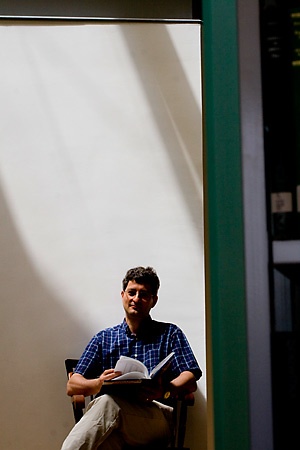May 21 2009
In the 1990s, semiconductor companies began to incorporate a wider variety of materials into the construction of computer chips, selecting materials based on how they would perform electrically and not necessarily on how they would stand up to the rigors of the manufacturing process or continued use.
 Joost Vlassak today is helping academia and industry understand how materials used in computer components and other electronics stand up to a variety of conditions. Rose Lincoln/Harvard News Office
Joost Vlassak today is helping academia and industry understand how materials used in computer components and other electronics stand up to a variety of conditions. Rose Lincoln/Harvard News Office
Harvard engineering Professor Joost Vlassak today is helping academia and industry catch up in their understanding of how materials employed in critical components for computers and other electronics stand up to a variety of conditions — and helping them use that knowledge to design new components and devices.
Vlassak, Gordon McKay Professor of Materials Engineering, has several different aspects of research focused on the performance of materials in the small amounts used for things such as microchips.
It turns out, he said, that in such minute quantities, some physical properties of materials change. Copper, for example, gets much stronger in tiny amounts — an important factor when copper is used in computer chips.
Understanding the fracture properties of thin films — thin layers of one substance deposited over another — is another key part of Vlassak’s work. Some films, for example, which are fine in a vacuum, break up when exposed to air because the films interact with water vapor in the atmosphere. That’s an important consideration in selecting materials that will not only perform as desired, but that need to be mass-produced if they’re to be used in consumer goods.
“They just worried about electrical performance, they didn’t worry about mechanics. It turns out that the mechanical properties of some of these materials are lousy,” Vlassak said. “We’re trying to gain insight as to what’s going on.”
His thin-film work extends to the design of flexible electronics, such as rollable display screens. The electronics are made by spraying materials or depositing them through other techniques on a flexible substrate. Vlassak is examining what happens to those materials as the substrate is flexed and rolled, and at what point the deformation of the material causes them to fail.
“We found that adhesion between the film and substrate is very important. If you have very good adhesion, the substrate suppresses failure,” Vlassak said.
Vlassak is also working on active materials. His work on “shape memory alloys” may lead to the development of new microcomponents. These alloys change shape under different environmental conditions — increased temperature or under a magnetic field, for example — and have potential applications in components such as microswitches.
Vlassak is examining the properties of materials used in these devices, some of which are extremely sensitive to the alloy’s composition. A one-tenth of a percent change in composition can sometimes mean a large change in performance, he said.
How things are made
Vlassak is from the college town of Leuven in Belgium. He grew up within a half mile of the University of Leuven, from which he received a master of science degree in metallurgical engineering in 1989.
Vlassak remembers always being interested in how things worked, recalling building minirockets and messing around with chemistry sets even as a kid. In high school, he had a classical education, studying Latin and Greek, but he also studied chemistry and physics.
At the University of Leuven, he briefly considered archaeology before embarking on an engineering program. He visited Stanford University for a summer internship and, upon graduating from the University of Leuven, returned to Stanford to do graduate work. He received a master’s degree in 1990 and a doctorate in 1994 in materials science.
At first, industry summoned the recently minted Ph.D. more compellingly than academia. Vlassak’s first job was with a start-up company in the Bay area that was working on innovative electronic design for the set-top boxes that connect viewers to cable television and satellite signals. The company had a lot of start-up money, but less than a year later, a failed initial stock offering doomed the enterprise. Hundreds were laid off. Though Vlassak was among a handful who survived the layoffs, he began looking for another job. He worked at National Semiconductor and then moved to Xerox PARC, working on a new type of acoustic print head that would print 70 to 80 color, photographic-quality pages per minute.
In 2000, Vlassak came to Harvard as an assistant professor. He was appointed Gordon McKay Professor of Materials Engineering in January 2007.
Today, Vlassak said his industry background may be unusual for an academic, but he’s found it helpful, as it lends him a unique perspective on his work. In collaboration with colleagues, he’s hoping to embark on a project that may prove important in the nation’s energy future — studying rechargeable batteries and the processes that make them lose capacity over time.
“They’re part of the whole energy debate,” Vlassak said.